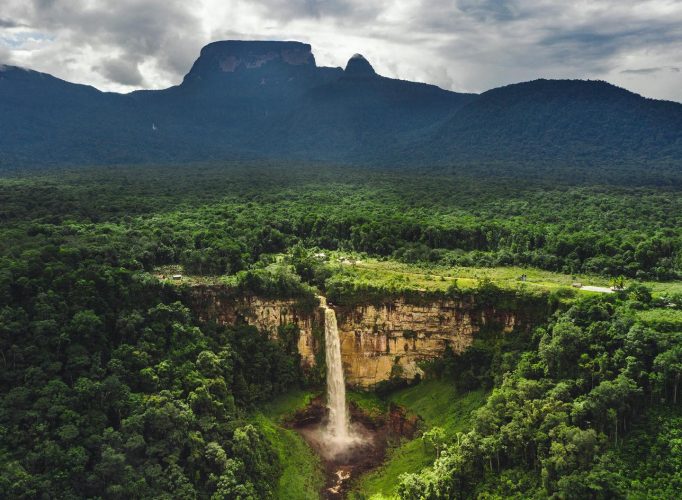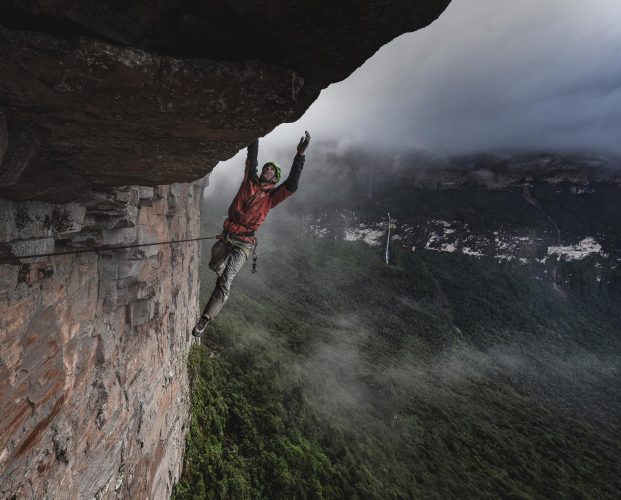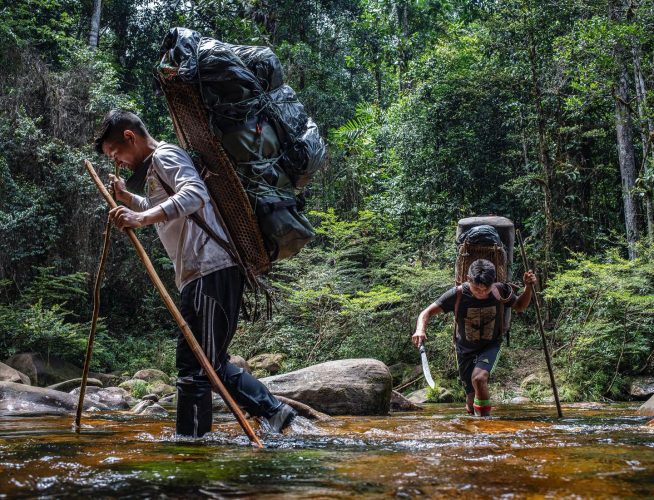By Tony Thorne
Guyana is featured in the cover story of the April edition of the National Geographic magazine. The feature, “Up the Mountain, to a World Apart,” is 36 pages inclusive of pull-outs and maps covering the full story of the adventure by climber Mark Synnott with stunning photography by Renan Ozturk. This level of coverage would easily be valued at US$1,000,000.00 and an immeasurable value in highlighting Guyana to the world.
Today, the Disney+ streaming service will air the one-hour National Geographic Explorer documentary, The Last Tepui, bringing even more attention to the amazing topography of Guyana. Undoubtedly the magazine story and the documentary will help thrust Guyana into the forefront of adventure-seeking tourists, adventurers, scientists and documentary-makers.
This is the story of how Wilderness Explorers, Guyana’s only Destination Management Company, worked alongside the indigenous communities to support the making of the feature story and documentary. It required the help and assistance of the Environmental Protection Agency, the Ministry of Tourism, Industry and Commerce, the Ministry of Amerindian Affairs and the Guyana Tourism Authority.

The highlands of western Guyana feature flat-topped mountains or tepuis and this wild and remote region of Guyana is rarely visited due to its rugged terrain. It is the perfect setting for adventurous scientific expeditions, where the unique micro-environments of the tepui tops hold nature’s secrets and yet-to-be recorded species.
The USA production company contacted Wilderness Explorers to get a world-class climbing team to the base of Mount Weiassipu to make the first ascent of the tepui for a film for National Geographic. The mountaineering team was led by Synnott, who has extensive climbing experience in Guyana including ascents of Mt. Roraima, and included Alex Honnold, who famously climbed Yosemite’s El Capitan without ropes as documented in the film Free Solo, and one of the world’s most experienced tepui mountaineers, Federico “Fuco” Pisani.
The expedition was to support scientist Dr. Bruce Means to get to the summit of Weiassipu, where he believed he would find new species of frogs. Dr. Means had previously made 32 expeditions in this region and he would turn 80 years old during this trip, which would probably be his last big expedition. The expedition was rounded out by an experienced crew of filmmakers, who were climbers themselves, and a wilderness doctor.
Communication to this remote area is limited and certainly not conducive to the level of complex planning required for such an arduous expedition. Therefore, a reconnaissance team flew out to the Akawaio community of Phillipai to scope out the area and establish effective lines of communication. The team of experienced nature guide Wally Prince and Wilderness Explorers’ Kenneth Shivdyal (Product Development Manager) was joined by Candace Phillips (Manager of Product Development) from the Guyana Tourism Authority.
Wilderness Explorers has been a Fixer or Location Producer for over 20 years, but this was our most challenging production. The logistical planning in an area we do not ordinarily operate and the long supply line through very arduous and remote terrain presented us with a situation that required very complex planning and delivery.
Synnott, the lead climber, had travelled to this region numerous times and Wilderness Explorers supported his ascent of Mt. Roraima in 2004. He had passed Weiassipu on that trip, as it sits next to Roraima and he and Dr. Means had been on top of Weiassipu by helicopter in the past, but its sheer face had never been climbed, a challenge he could not ignore.
He had a plan to get to the base of the tepui following the route to Roraima before branching off at right angles at Double Drop Falls, which required a trail to be blazed through thick rainforest to the base of the sheer north face of the tepui. This required recruitment of a strong team of 73 men and women from Phillipai and Wayalaleng, who would support the expedition.
When the main expedition team flew into Phillipai, they took a river journey with their equipment up the Kukui and Ataro rivers to the village of Wayalaleng, with its stunning waterfall and backdrop of the Marigma tepui. From this last tiny outpost of civilisation, the party set off into the sea of rainforest, filled with sucking mud, bugs, non-stop rain and long days, inching the 40 miles towards the tepui. Synnott said, “The jungle just swallows you down day after day. We were constantly soaked and slathered in mud. We called it living in mud world”.

For Dr. Means, though, this was a frog paradise. The Amazon Basin alone has more than a thousand species and that is probably only a fraction of the total number, with many still left to be discovered and recorded. He said, “The potential for future discoveries in the Pawikwa is virtually limitless.” However, species are disappearing at an alarming rate, with some estimating that up to 200 species may have gone extinct since the 1970s.
But the arduous trek through the forest took its toll on Dr. Means, so the team split up with the climbing team moving ahead to cut a 5-mile trail to the base of Weiassipu’s north face. Eventually, they made it through to Double Drop Falls, a roaring 200-foot cascade, where a base camp was set up, so the team could begin to blaze a trail to the tepui. Meanwhile, Dr. Means and a team of the Akawaio would collect specimens at Double Drop Falls.
The climbers and supporting team hauled a thousand feet of rope and three hanging cots, called portaledges, for camping on the side of the cliff, plus rations through the forest to the base of the tepui. The plan was to set a rope course up the face of the cliff and then haul Dr. Means up the front in a portaledge. In the end, the expedition doctor, Brian Irwin, convinced Dr. Means that it was just too risky for someone his age and the plan changed. Instead, Pisani would look for the frog species on the tepui top that the scientist so badly wanted to collect. Dr. Means would stay at Double Drop Falls camp and search for species in this area.

Honnold, Pisani and Synnott scaled the north face of Weiassipu, sleeping with their portaledges anchored to the wall at 700 feet above the jungle. Pisani searched for the Stefania frog on the tepui top, but was unsuccessful. When they returned to the bottom and met up with Dr. Means at the new Sloth Camp, they were greeted with what he believed was a Stefania that they found in the cloud forest near the camp.
Dr. Means’ condition had deteriorated to a point where the decision was made to extract him by helicopter. Capt. Akeem Stoll from Air Services’ video of the flight highlighted the tiny area he had to land in and he expertly dropped the helicopter into the zone, whilst being buffered by the wind created by the falls. Dr. Means was safely extracted and the risky flight was just another component to an adventurous and challenging expedition.
The rest of the crew had the unenviable task of trekking back over the 40-miles of swamp, rivers, mud, incessant rain and rainforest and then boat back to Phillipai. Later, local Akawaios Edward Jameson and Troy Henry were presented with medals sent by President Irfaan Ali to commemorate their climb on the 1,500-foot prow of Roraima with a British expedition in 2019.
The forest skills and tenacity of the Akawaio were a key component to the expedition’s success. They foraged in the forest to find frogs, lizards and snakes for Dr. Means to study. They hauled mountains of ropes, climbing gear, rations, and tarpaulins across inhospitable terrain, crossing swollen rivers and being drenched daily by heavy rain. Without them, the climbers would never have made the tepui summit.

Covid-19 brought global tourism to a jolting halt and Guyana was no exception. Airlines, hotels, transportation companies and many others all provided services that ensured the success of this expedition. Being able to pivot our tourism skills to focus on the role of Location Producer to support such a journey meant desperately needed work and income. It resulted in earnings of G$20,000,000.00 for the communities at Phillipai and Wayalaleng.
For those communities, there is little opportunity to earn an income. Tourism offers a pathway for residents to use their land, local knowledge, and skills to create employment without needing to leave their home villages. Over 70 men and women were involved for nearly a month, supporting the 10 climbers, filmmakers, scientists and the doctor to reach Weiassipu. The village guesthouse provided accommodation and meals, boats were rented and rations were purchased from the village shop.
Recently, I communicated with Dr. Means and learned that his research of the species collected continues. He wrote: “The preliminary scientific news is that I have 3 species of frogs, one lizard, and probably one snake new to science. Moreover, I did document a couple dozen known species from the elevational transect we made. Now the hard work begins as each new species requires laboratory work and a write-up for scientific publication. This will take some time.”
The National Geographic cover story is available online. There are also short videos that provide a level of insight into the adventure.
And this video is of the trip that inspired the expedition:
In 2021, Wilderness Explorers also supported another National Geographic production, Primal Survivor, which first aired in the UK on April 14th and will be released in the USA very shortly. That was a five-part series filmed across Guyana, providing more adventures and extraordinary stories about Guyana.
Wilderness Explorers would like to sincerely thank the following for their part in pulling off the astonishing expedition to Weiassipu: The Toshao and council, men and women of the Akawaio at Phillipai and Wayalaleng, Wally Prince, Leon Moore, Air Services Limited, the Ministry of Amerindian Affairs, the Guyana Tourism Authority, the Ministry of Tourism, Industry and Commerce, the Environmental Protection Agency, Cara Lodge, and our hard-working team.
Tony Thorne is the Managing Director of Wilderness Explorers





